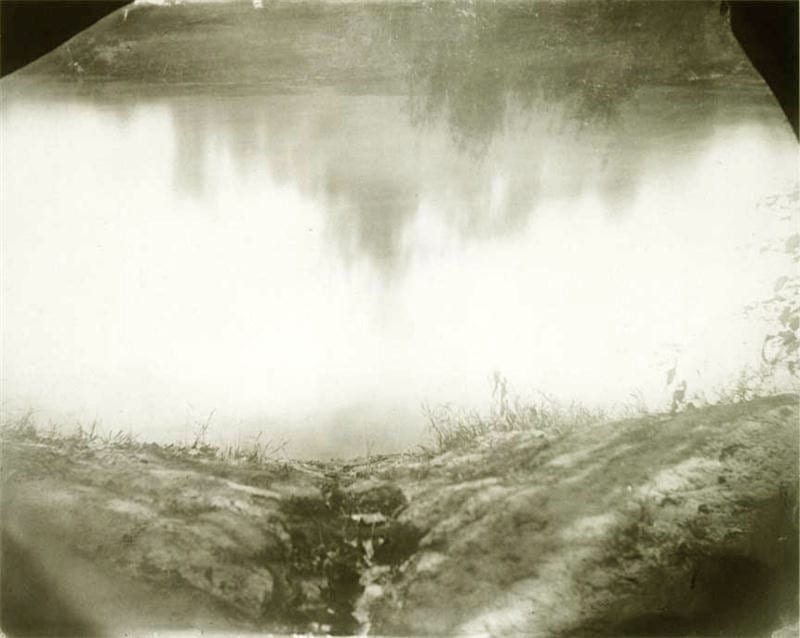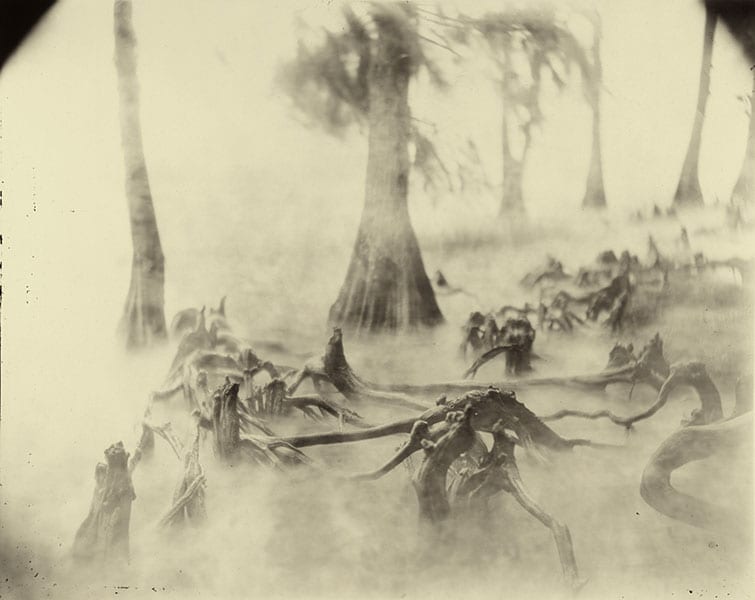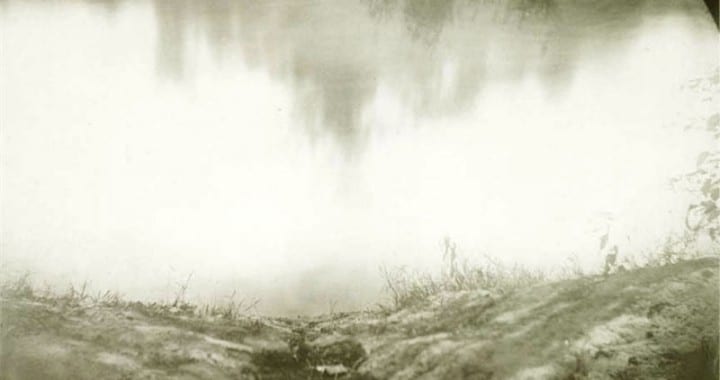
Untitled (Mississippi Landscape), 1998. (fig. 1)
By Alison R. Hafera, An Excerpt from “Taken in Water: The Photograph as Memorial Image in Sally Mann’s Deep South” (2007)
‘What have they done?’ cries the child / ‘Why have they beaten me, tortured me, / wound me in wire from the cotton gin that tore our years across / sunk me deep in the river of no forgetting? Martha Millet1
In August 1955 Emmett Louis Till, a fourteen-year-old black boy, left his hometown, Chicago, Illinois, to visit his mother’s relatives in rural Mississippi. Emmett is described as someone who loved telling and hearing jokes, someone who occasionally acted with impunity (lighting firecrackers within the city limits), and a good student in science and art.2 He spent his long summer days in Mississippi helping his great uncle pick cotton in the Delta fields, chasing snakes out of a pond with his cousins so that they could swim in the heat of the day, and taking trips to the nearby town of Money to buy a cool drink and a few pieces of candy. On August 28, he and his cousins walked into Bryant’s Grocery store and what happened between young Emmett and Carolyn Bryant, the twenty-one year old white wife of Roy Bryant, the owner of the store, will never be known for certain. Emmett spoke regularly of both black and white friendships, with both boys and girls. It is possible that his cousins dared him to speak to Mrs. Bryant, to prove that he was not afraid to have conversations with white women. Emmett is said to have whistled, possibly on purpose or as a symptom of a stutter brought on from a childhood case of polio (his mother told him to whistle when he could not form words.)3 Mrs. Bryant refused to repeat what Emmett said to her, but she did testify to a juryless courtroom that he touched her wrist and grabbed her by the waist.4 Whatever did in fact happen in the isolated, rural store that day led to the kidnapping and murder of Emmett Till by Roy Bryant and his half brother J.W. Milam. The men disposed of Emmett’s body in the Tallahatchie River, tying a seventy-five pound cotton gin fan around his neck to insure that his body would remain submerged within the river’s indolently moving water. He was meant to be lost, to be made invisible, to be carried unseen and undiscovered through the interconnected water system of the Mississippi Delta, beneath the water’s cloudy membrane, silenced and forgotten. Southern photographer Sally Mann does not want to forget.
Rivers and deep bodies of water are mythically associated with memory formation and retention, especially the inevitable act of forgetting. For the ancient Greeks the river Lethe was able to erase a dead soul’s entire memory of life with only one drink.5 The Tallahatchie River is a deep, muddy backwater river, rising in northwestern Mississippi before dropping into the dark, flat marsh lands known as “the Delta.” The Tallahatchie is only one veiny water source that feeds the Mississippi Delta, a place identified by its especially fertile flood plains, relative isolation, and shockingly violent racial history. When Mann, a photographer known for her compelling familial series Immediate Family (1984-1991) who recently turned to landscapes, first visited Mississippi in the fall of 1998 she experienced the unique sensation of traveling “into the Delta;” the implication being not only traveling through physical space but rather of passage back in time, to a setting that seems even more southern that the rest of the state.6 Even for Mann, a native Virginian and a photographer skilled at capturing the allusive formality of the southern vernacular of family, land, memory and loss, the Mississippi landscape represents an otherworldly place. She describes the unique aroma of the fertile plains, the whirling “tornadoes” of cotton flies and the “lazy shafts of Mississippi light” with the wonder of someone seeing the southern landscape for the first time.7

Untitled (Deep South #30: Boney Swamp), 1998 from Deep South
Commonly referred to as “the most southern place on earth”8 the torrid and proliferant Mississippi Delta somehow appears to transcend the continuum of time. In the text that accompanies the photographs in Deep South9, Mann describes the power that the particular Delta landscape held over her ability to judge and record time:
From the moment I passed into Mississippi, my time became ecstatic. A radiance coalesces about the landscape, rich in possibility, supercharged with something electric. Time slows down. Time becomes ecstatic… I broke through into that dimension of revelation and ecstasy that eludes historical time.10
Because of this unique sensation of suspended time, of eluding historical time, Mann’s southern excursion into the Mississippi Delta afforded the opportunity to study and photograph in sharply defined geographical miniature the particular history and culture of the Deep South. Furthermore, in Deep South (1998), Mann’s landscape series that includes the Mississippi images, the landscape becomes uniquely held by a photograph which is itself a practice of time travel. Through the photographic image the past is brought into the present with a promise of existing into the future.
The element of suspended time Mann percieves in the Southern landscape also has a wounding effect. She finds that living in the South and traveling through its landscape “often means slipping out of temporal joint, a peculiar phenomenon that both nourishes and wounds.”11 The sensation of nourishment and wounding that comes from slipping between time stems from a seeming closeness with a past that is itself wounded by violence and segregation. Her particular journey into Mississippi eventually takes her to the shores of the Tallahatchie River and to a plot of southern land deeply symbolic in its confluence of past and present, history and death as told through the formal evocation of a physically wounded earth. If in Mississippi time slows to a morbid crawl, then the Tallahatchie River had barely enough time to wash away any evidence deposited along its red-clay shores of Emmett Till’s kidnapping and murder before Mann encounters the spot in October 1998.
The Tallahatchie photograph, identified like all the images in the series as simply Untitled (Mississippi Landscape) (fig.1), was “taken one serenely mote-floating, balmy, yellowish October afternoon” and the image is itself yellow and steamy. The moistness and tonality of the image possibly reflects Mann’s use of the nineteenth century wet-plate collodion process. The collodion technique consists of carefully coating a glass plate with a solution of nitrated cotton dissolved in ether and alcohol.12 The Mississippi images in Deep South represent Mann’s initial experimentation with wet-plate collodion and the choice to use the nineteenth century process seems a deliberate choice based on the solitude and timelessness Mann finds in the Mississippi landscape:
That part of the South is a kind of netherworld. I was asking the land to give up its ghosts. Collodion is the ideal medium for such landscapes. It is contemplative, memorial… In the face of some extraordinary sight or place you do not just take a picture. It is ceremonial. I am not a religious person, but there is an experience of communion in wet-plate photography. It is not a drive-by shooting.13
To describe an experience as communion carries both bodily and spiritual connotations; a person feels connected to the land as if they are “taking a part” of the place with them in their memory as they leave or the consumption of the physical body by the earth which eventually takes every(body). Following in the same spiritual evocation, with the collodion process the land can be seen as becoming sanctified through a series of on-site bathes and pourings.
The placid stillness of the Tallahatchie photograph reflects the amount of time spent within the landscape, preparing the plate, capturing the image and developing the negative. Vaporous and breathless, as if all the air has been sucked out of the space, the image seems to slowly peel itself open to the viewer while the darkened, unexposed edges collapse and push in on the central cut in the clay dirt near the shoreline, combining to create a sense of inescapable claustrophobia. The central cut is moist, jagged and deep, and the gently rounded earth on either side appears to give way to its weighted pull. The earthen spot directly around the cut’s rough edges is barren of any vegetal growth as if the ground, having been sapped of all its nutrients, is unable to support new life. The cut seems to descend rapidly into the deep waters of the Tallahatchie River just beyond, quickly disappearing from sight beneath the river’s murky, opaque skin.
Within the text of Deep South Mann identifies this photographed place as “the very spot from which the fourteen-year-old Emmett, naked and necklaced with a cotton- gin fan, was heaved into the Tallahatchie River.”14 As the scar in the clay ground descends into the river and disappears beneath the water, so too was Emmett’s body taken away in the slowly moving fluid. In Mann’s watery landscape the integral relationship between the wounded earth and the flowing water is reflected in the darker gestural reference of foliage mirrored in the Tallahatchie water which drags and points to the heavily broken earth. The river water beyond is still, flat, placid as if, just like time, the flowing water of the Tallahatchie River has slowed to an eerie stop in reverence to Mann’s memorial photograph. The ceremonial quality of the photographic moment is strengthened by the subtle encroachment of rough grasses and vines along the edge of the photograph; like the image, the flora and fauna peel away from this hallowed ground, their weighted stems, heavy with humidity, bow towards the ground and water, allowing only a momentary glimpse of the existence of this humble and haunted place to photographer and viewer.
The story I tell is the story of Emmett’s death as embodied within Sally Mann’s memorial to him made manifest in a photograph of the muddy Tallahatchie waters. Within the image the reference to an open wound, more capable of maintaining the emotive traces of the painful trauma of Till’s murder than his own open casket, symbolically connotes both the physical and historical scars of Emmett’s murder. Mann’s particular exploration of the Southern landscape in this photograph of the Tallahatchie shoreline seems to beg the question, does a place remember? I am interested in the memorial function of photography as a materialization of both personal and public memory. By exploring the mythic, memorial and historic associations with watery landscapes, I read Mann’s Tallahatchie image as capable of opening the narrative of Till’s short life and violent death through layered acts of recollection. Where much attention has been paid to how Mann’s landscapes are associated with the memory of the Civil War and the antebellum South,15 or the formal elements of romanticism, I am interested in how her landscapes might engage with personal memory and a more complicated investigation of the haunted Southern past. Her landscape becomes the truest posthumous portrait of Emmett Till, capturing the painful essence of the culture that killed him as held in memory by the Southern motherland.
Notes
1 Martha Millet, “Mississippi,” Masses and Mainstream, October 1955.
2 From interviews with Till’s mother Mamie Till Mobley and his cousins Wheeler Parker and Simeon Wright. See Keith Beauchamp, The Untold Story of Emmett Louis Till; Christopher Metress, ed. The Lynching of Emmett Till: A Documentary Narrative (Charlottesville: University of Virginia Press, 2002), 226-235; Stephen J. Whitfield, A Death in the Delta: The Story of Emmett Till (New York: Free Press; London: Collier Macmillan, 1988), 23-24.
3 Whitfield, looking at contemporary newspaper reports, discovers that at least two of Till’s cousins claimed that Till “was definitely whistling” at Carolyn Bryant. See A Death in the Delta, 19. When William Bradford Huie later interviewed the cousins he said that neither of them had mentioned the whistle until he asked them about it; then they only agreed that Emmett “may have whistled, at the store. But it had not struck them as important” See Metress, 243.
4 The judge orders the jury out of the courtroom when Mrs. Bryant giver her testimony in court, citing the exchange between defense attorneys and Carolyn Bryant as inadmissible. Ibid., 309.
5 See Patricia Turner and Charles Russell Coulter, Dictionary of Ancient Dieties (New York: Oxford University Press, 2001), 289. For a reference on many mythic and literary references to forgetting see Harold Weinrich, Lethe: The Art and Critique of Forgetting (Ithaca: Cornell University Press, 2004).
6 Sally Mann, Immediate Family (Aperture: New York, 1992).
7 Sally Mann, Deep South (New York: Bulfinch Press, 2005), 49.
8 This phrase is used by James C. Cobb and is also the title of his book on the region. In the preface of the text, Cobb writes: “In May 1985 I appeared on a Center for the Study of Southern Culture videotape, standing in a cotton field on the outskirts of Marks, Mississippi, describing the Mississippi Delta as a land of astounding economic and social disparity and declaring it ‘the most southern place on earth.’ Although at the time I felt terribly pleased with the cleverness and originality of my observation, I soon learned that I was actually but one of a host of commentators who over the years have treated the Mississippi Delta as an isolated, time-warped enclave.” See James C. Cobb, The Most Southern Place on Earth: The Mississippi Delta and the Roots of Regional Identity (New York: Oxford University Press, 1992), vii.
9 There are two series of Southern landscapes by Sally Mann: Motherland which includes photographs of Virginia and Georgia, and Deep South, which includes photographs of Mississippi and Louisiana. Originally, Motherland was shown at the Edwynn Houk Gallery in New York in 1996. Deep South was shown in 1999 at the Edwynn Houk Gallery as well. Although I am unable to quote the total official number of photographs included in Mann’s Southern landscapes, in the latest publication of the two series there are sixty five plates included. See Deep South. I address only five photographs in this paper, selecting images that I see as specifically associated with the themes of the watery landscapes, the use of the wet- plate collodion process, and evocation of a precise historical moment through memory. According to Mann, her landscapes from Motherland and Deep South are the most popular and sell more than any of her other photographic series. See What Remains: The Life and Work of Sally Mann. directed by Steven Cantor, produced by Steven Cantor, Daniel Laikind, Mandy Stein, Pax Wasserman. USA, 2006, 86 minutes, video. For information on Mann’s landscapes also see Sally Mann, Motherland: Recent Landscapes of Georgia and Virginia. New York: Edwynn Houk Gallery, 1997.
10 Mann, Deep South, 49.
11 Mann, Deep South, 7.
12 Wet-plate or collodion photography was invented in 1851 by the Englishman Frederick Scott Archer. The coated plate is bathed in silver nitrate to make the surface sensitive to light and exposed in the camera while the collodion is still wet. The resultant collodion has a syrupy consistency that is then poured onto clean, tilted glass plate as the first step in the production of a negative. The coated glass plate is then sensitized by bathing it in a solution of silver nitrate to make the surface sensitive to light. The plate is then developed and fixed. For most working photographers, wet-plate negatives were preferable to paper negatives because of their great clarity and speed. See Gordon Baldwin, Looking at Photographs: a Guide to Technical Terms (London: J. Paul Getty Museum and British Museum, 1991), 27.
13 Interview with Sally Mann. See Lyle Rexer, from Photography’s Antiquarian Avant-Garde: The New Wave in Old Processes (New York: Harry N. Abrams, 2002), 80-81.
14 Mann, Deep South, 50-51.
Deep South.
Photographs by Sally Mann.
Bulfinch, 2005. Cat# BF203 ISBN-10: 0821228765
Immediate Family.
Photographs by Sally Mann. Afterword by Reynolds Price.
Aperture, 1992. Cat# AP270 ISBN-10: 0893815187
ASX CHANNEL: SALLY MANN
[nggallery id=244]
